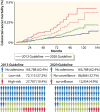New risk stratification after colorectal polypectomy reduces burden of surveillance without increasing mortality
- PMID: 34343405
- PMCID: PMC8498405
- DOI: 10.1002/ueg2.12119
New risk stratification after colorectal polypectomy reduces burden of surveillance without increasing mortality
Abstract
Background: The 2020 postpolypectomy surveillance guideline update of European Society for Gastrointestinal Endoscopy defines a more restrictive group of individuals in need for surveillance 3 years after colonoscopy.
Aim: The aim of this cohort study was to validate the new guideline recommendation.
Methods: Based on a national quality assurance program, we compared the 2020 risk group definition with the previous 2013 recommendations for their strength of association with (1) colorectal cancer death, and (2) all-cause death.
Results: A total of 265,608 screening colonoscopies were included in the study. Mean age was 61.1 years (SD ±9.0), and 50.6% were women. During a mean follow-up of 59.3 months (SD ±35.0), 170 CRC deaths and 7723 deaths of any cause were identified. 62.4% of colonoscopies were negative and 4.9% were assigned to surveillance after 3 years according to the 2020 guidelines versus 10.4% following the 2013 guidelines, which corresponds to a relative reduction in colonoscopies by 47%. The strength of association with CRC mortality was markedly higher with the 2020 surveillance group as compared to the 2013 guidelines (HR 2.56, 95% CI 1.62-4.03 vs. HR 1.73, 95% CI 1.13-2.62), while the magnitude of association with CRC mortality for low risk individuals was lower (HR 1.17, 95% CI 0.83-1.63 vs. 1.25, 95% CI 0.88-1.76).
Conclusions: Adherence to the updated guidelines reduces the burden of surveillance colonoscopies by 47% while preserving the efficacy of surveillance in preventing CRC mortality.
Keywords: CRC; cancer; colonoscopy; colorectal cancer; mortality; polypectomy; risk-stratification; screening; surveillance.
© 2021 The Authors. United European Gastroenterology Journal published by Wiley Periodicals LLC. on behalf of United European Gastroenterology.
Conflict of interest statement
The authors have no conflicts of interest to declare.
Figures




Similar articles
-
Follow-up after colorectal polypectomy: a benefit-risk analysis of German surveillance recommendations.Int J Colorectal Dis. 2007 Aug;22(8):929-39. doi: 10.1007/s00384-006-0252-0. Epub 2007 Feb 6. Int J Colorectal Dis. 2007. PMID: 17279350
-
Colonoscopist Performance and Colorectal Cancer Risk After Adenoma Removal to Stratify Surveillance: Two Nationwide Observational Studies.Gastroenterology. 2021 Mar;160(4):1067-1074.e6. doi: 10.1053/j.gastro.2020.10.009. Epub 2020 Oct 14. Gastroenterology. 2021. PMID: 33065063
-
Computer aided detection and diagnosis of polyps in adult patients undergoing colonoscopy: a living clinical practice guideline.BMJ. 2025 Mar 27;388:e082656. doi: 10.1136/bmj-2024-082656. BMJ. 2025. PMID: 40147837
-
Adherence to post-polypectomy surveillance guidelines: a systematic review and meta-analysis.Endoscopy. 2019 Jul;51(7):673-683. doi: 10.1055/a-0865-2082. Epub 2019 Mar 25. Endoscopy. 2019. PMID: 30909308
-
Post-polypectomy Guideline Adherence: Importance of Belief in Guidelines, Not Guideline Knowledge or Fear of Missed Cancer.Dig Dis Sci. 2015 Oct;60(10):2937-45. doi: 10.1007/s10620-015-3685-x. Epub 2015 May 7. Dig Dis Sci. 2015. PMID: 25947332 Free PMC article. Review.
Cited by
-
Accuracy of a faecal immunochemical test in patients under colonoscopy surveillance of colorectal adenoma and cancer.Ups J Med Sci. 2023 Jun 23;128. doi: 10.48101/ujms.v128.8869. eCollection 2023. Ups J Med Sci. 2023. PMID: 37441110 Free PMC article.
-
Impact of the European Society of Gastrointestinal Endoscopy 2020 guidelines on the number of scheduled post-polypectomy surveillance colonoscopies: Meeting presentations: Partial results of this research were published in abstract form at ESGE Days 2020.Endosc Int Open. 2022 Sep 14;10(9):E1238-E1244. doi: 10.1055/a-1905-0155. eCollection 2022 Sep. Endosc Int Open. 2022. PMID: 36118644 Free PMC article.
-
Maximizing scarce colonoscopy resources: the crucial role of stool-based tests.J Natl Cancer Inst. 2024 May 8;116(5):647-652. doi: 10.1093/jnci/djae022. J Natl Cancer Inst. 2024. PMID: 38310359 Free PMC article.
-
Use of surveillance colonoscopy among individuals with removal of high-risk polyps according to the US Multi-Society Task Force recommendations.Cancer. 2023 May 1;129(9):1394-1401. doi: 10.1002/cncr.34692. Epub 2023 Feb 17. Cancer. 2023. PMID: 36807015 Free PMC article.
References
-
- Bray F, Ferlay J, Soerjomataram I, Siegel RL, Torre LA, Jemal A. Global cancer statistics 2018: GLOBOCAN estimates of incidence and mortality worldwide for 36 cancers in 185 countries. CA A Cancer J Clin. 2018;68 (6):394–424. - PubMed
-
- Cottet V, Jooste V, Fournel I, Bouvier AM, Faivre J, Bonithon‐Kopp C. Long‐term risk of colorectal cancer after adenoma removal: a population‐based cohort study. Gut. 2012;61(8):1180–6. - PubMed
Publication types
MeSH terms
LinkOut - more resources
Full Text Sources
Medical

